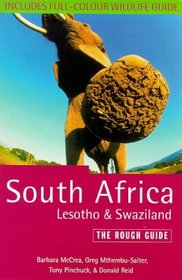Search -
The Rough Guide to South Africa, 2nd Edition (Rough Guide South Africa)
The Rough Guide to South Africa 2nd Edition - Rough Guide South Africa
Author:
Introduction South Africa is a large and massively diverse country. The size of France and Spain combined, it varies from the picturesque Garden Route towns of the Western Cape to the raw stretch of subtropical coast in northern KwaZulu-Natal. It's also one of the great cultural meeting points of the African continent, a fact obscured by year... more »
Author:
Introduction South Africa is a large and massively diverse country. The size of France and Spain combined, it varies from the picturesque Garden Route towns of the Western Cape to the raw stretch of subtropical coast in northern KwaZulu-Natal. It's also one of the great cultural meeting points of the African continent, a fact obscured by year... more »
ISBN-13: 9781858284606
ISBN-10: 1858284600
Publication Date: 11/1/1999
Pages: 736
Edition: 2
Rating: ?
ISBN-10: 1858284600
Publication Date: 11/1/1999
Pages: 736
Edition: 2
Rating: ?
0 stars, based on 0 rating
Genres:
- Travel >> Africa >> General
- Travel >> Africa >> Lesotho
- Travel >> Africa >> South Africa >> General
- Travel >> Africa >> Swaziland
- Travel >> Reference >> Guidebooks
- Travel >> Travel Writing
- Travel >> Guidebook Series >> Rough Guide





